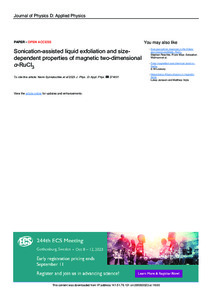| dc.date.accessioned | 2023-08-30T09:22:55Z | |
| dc.date.available | 2023-08-30T09:22:55Z | |
| dc.date.issued | 2023-04-26 | |
| dc.identifier | doi:10.17170/kobra-202308288701 | |
| dc.identifier.uri | http://hdl.handle.net/123456789/15039 | |
| dc.description.sponsorship | Gefördert im Rahmen des Projekts DEAL | |
| dc.language.iso | eng | |
| dc.rights | Namensnennung 4.0 International | * |
| dc.rights.uri | http://creativecommons.org/licenses/by/4.0/ | * |
| dc.subject | liquid phase exfoliation | eng |
| dc.subject | RuCl₃ | eng |
| dc.subject | 2D material | eng |
| dc.subject | size selection | eng |
| dc.subject | nanomaterial stability | eng |
| dc.subject.ddc | 530 | |
| dc.title | Sonication-assisted liquid exfoliation and size-dependent properties of magnetic two-dimensional α-RuCl₃ | eng |
| dc.type | Aufsatz | |
| dcterms.abstract | Originating from the hexagonal arrangement of magnetic ions in the presence of strong spin orbit coupling, α-RuCl₃ is considered as model system for the Kitaev-Heisenberg model. While the magnetic properties of α-RuCl₃ have been studied in bulk single crystals or micromechanically-exfoliated nanosheets, little is known about the nanosheets' properties after exfoliation by techniques suitable for mass production such as liquid phase exfoliation (LPE). Here, we demonstrate sonication-assisted LPE on α-RuCl₃ single crystals in an inert atmosphere. Coupled with centrifugation-based size selection techniques, the accessible size- and thickness range is quantified by statistical atomic force microscopy. Individual nanosheets obtained after centrifugation-based size selection are subjected to transmission electron microscopy to confirm their structural integrity after the exfoliation. The results are combined with bulk characterisation methods, including Raman and x-ray photoelectron spectroscopy, and powder diffraction experiments to evaluate the structural integrity of the nanosheets. We report changes of the magnetic properties of the nanomaterial with nanosheet size, as well as photospectroscopic metrics for the material concentration and average layer number. Finally, a quantitative analysis on environmental effects on the nanomaterial integrity is performed based on time and temperature dependent absorbance spectroscopy revealing a relatively slow decay (half-life of ∼2000 h at 20 °C), albeit with low activation energies of 6–20 kJ mol-¹. | eng |
| dcterms.accessRights | open access | |
| dcterms.creator | Synnatschke, Kevin | |
| dcterms.creator | Jonak, Martin | |
| dcterms.creator | Storm, Alexander | |
| dcterms.creator | Laha, Sourav | |
| dcterms.creator | Köster, Janis | |
| dcterms.creator | Petry, Julian | |
| dcterms.creator | Ott, Steffen | |
| dcterms.creator | Szydłowska, Beata | |
| dcterms.creator | Düsberg, Georg S. | |
| dcterms.creator | Kaiser, Ute | |
| dcterms.creator | Klingeler, Rüdiger | |
| dcterms.creator | Lotsch, Bettina Valeska | |
| dcterms.creator | Backes, Claudia | |
| dcterms.extent | 12 Seiten | |
| dc.relation.doi | doi:10.1088/1361-6463/accc3e | |
| dc.subject.swd | Zweidimensionales Material | ger |
| dc.subject.swd | Flüssiger Zustand | ger |
| dc.subject.swd | Nanostrukturiertes Material | ger |
| dc.subject.swd | Ruthenium | ger |
| dc.type.version | publishedVersion | |
| dcterms.source.identifier | eissn:1361-6463 | |
| dcterms.source.issue | Number 27 | |
| dcterms.source.journal | Journal of Physics D: Applied Physics | |
| dcterms.source.volume | Volume 56 | |
| kup.iskup | false | |
| dcterms.source.articlenumber | 274001 | |


